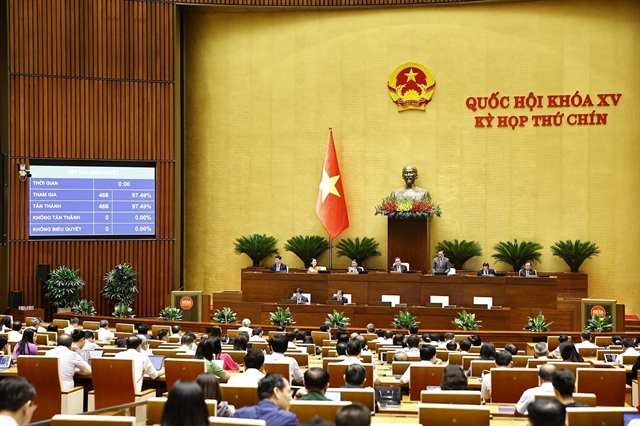 Politics & Law
Politics & Law


|
| Lawmakers on June 16 voted to adopt the revised Law on Local Government Organisation during the sitting in Hà Nội. — VNA/VNS Photo Doãn Tấn |
HÀ NỘI — The 15th-tenure National Assembly on Monday officially adopted the revised Law on Local Government Organisation during its 9th sitting, with 100 per cent of the 466 deputies present voting in favour.
This law reflects a renewed mindset geared toward modern, development-oriented local governance. It aims to eliminate systemic bottlenecks, unlock resources, and meet the goals of rapid and sustainable growth at both local and national levels in Việt Nam’s new development era.
The legislation also carries great historical significance, as it lays a solid legal foundation for the first-ever implementation of a two-tier local government model in the country.
Presenting the report on amendments to the draft law, Minister of Home Affairs Phạm Thị Thanh Trà stated that the revised law formally establishes a two-tier local government structure (provincial and communal levels), removing the district level authorities in between, clearly defining responsibilities, powers, and organisational structure at each level.
It also sets a comprehensive legal basis for local governance models in special administrative, economic units.
In response to National Assembly deputies’ feedback, the Government has refined and added provisions on administrative units, and principles for organising and operating local government to ensure streamlined, effective and efficient administration that is closer to and better serves the people. The law also fully embodies the principle of 'local decisions, local implementation, local accountability', promoting autonomy and accountability within local administrations.
On the matter of authority delineation, delegation, and decentralisation, to institutionalise the Party's and Politburo’s directions, the law now details the principles of power distribution between central and local governments, as well as between the provincial and communal levels. It also distinguishes responsibilities between collective bodies such as People’s Committees and individual leaders such as Chairpersons, encouraging flexible, effective decision-making and leadership creativity.
Amendments include: recognising provincial People’s Councils and Chairpersons as decentralising authorities; establishing monitoring mechanisms for delegated powers; empowering provincial Chairpersons to directly manage and resolve issues within their remit and across administrative branches to prevent procedural backlogs and inefficiencies.
Based on authority delineation principles, the law comprehensively redefines the tasks and powers of the two-tier system to avoid overlap and ensure modern, fit-for-purpose governance. These definitions also provide a legal foundation for other specialised laws to clearly assign responsibilities to each tier in relevant fields.
Adjustments include: reallocating certain powers from People’s Committees to their Chairpersons – resulting in provincial People’s Committees having 12 groups of duties and powers, and Chairpersons 23; for communal-level bodies, 10 and 17 respectively. Chairpersons may now act on behalf of the Committee in areas not requiring collective discussion, with reporting required at the next Committee session.
“This is a bold reform step to enhance leadership accountability and invigorate local governance. The revised law empowers local government leaders with greater autonomy, flexibility, and responsibility, in line with the practical needs of administrative management,” said Minister Trà.
Structure, transition, and implementation readiness
On the structure and functioning of local government, the revised law blends selective inheritance and innovation. New provisions include: establishing two committees under communal People’s Councils (Economic–Budget and Cultural–Social); retaining the existing minimum and maximum number of deputies; setting principles allowing for full-time provincial and communal-level deputies and assigning the Standing Committee of the NA authority to determine their number, enabling flexibility aligned with local realities and future policy directions.
Ensuring seamless operation from July 1, 2025
Minister Trà underscored that the transition from a three-tier to a two-tier local government system is a historically significant reform. To ensure uninterrupted administration, the law comprehensively anticipates transitional issues—from personnel and administrative processes to operational mechanisms.
Based on feedback from lawmakers, the revised law includes transitional provisions for wards in Hà Nội, Hồ Chí Minh City and Đà Nẵng, which currently follow an urban governance model (with only People’s Committees). From July 1, 2025, these wards will transition to full local government structures with both People’s Councils and Committees.
Additional transitional provisions ensure smooth handover of responsibilities and administrative processing from now-defunct district-level governments without disrupting services or affecting people and businesses.
To address unforeseen situations not yet codified in law, the revised legislation establishes a flexible, proactive mechanism authorising the National Assembly Standing Committee, Government, Prime Minister, ministers, and provincial governments to issue or authorise documents to resolve emergent governance issues—building on precedents such as Resolution No 190/2025/QH15. — VNA/VNS